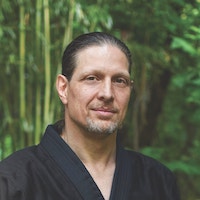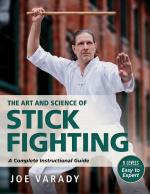There is a famous saying attributed to the famous Chinese philosopher Lao Tzu, “Every journey starts with a single step.”
My personal journey in the martial arts began over 35 years ago. For some, that is a long time, while for others, it is but a good start. In that time, I have studied many arts under many instructors, competed in many tournaments, and even won a few championships. Over the past 3 decades, I have instructed hundreds of students, a few of which went on to compete and win championships themselves. I have earned the rank of seventh degree black belt and been awarded the title of Grandmaster. However, a black belt is just a white belt that didn’t quit, and every master was once a beginner. I’d like to rewind the tape and show you where my journey began.
In 1983, I was a 14-year-old kid hooked on Saturday afternoon kung-fu flicks. I loved training with weapons, especially the staff and nunchaku, but I had yet to begin any formal training. My teachers were all in the pages of my small but treasured library of martial arts books. They were mostly second-hand, scavenged from garage sales and used book stores. It felt like panning for gold, searching through boxes of paperbacks for that rare tome on exotic fighting arts. To me, these books held the hidden secrets of the martial arts that would make me an incredible kung fu fighter, like my Saturday afternoon heroes.
Of course, today you can search the internet and find a plethora of material on a wide variety of martial arts styles. Sites such as YouTube allow anyone to have quick access to teachings by experienced (and, unfortunately, sometimes not so experienced) instructors from literally all around the globe, but in the 1980s this was not the case. For me, a kid living in rural Pennsylvania, it was information that was difficult to come by, but I was young and eager to learn.
Dr. Yang an Early Influence
Because I was such a fan of the kung-fu movie genre, I held a certain reverence for anything associated with China’s famous Shaolin Temple. You can imagine my excitement when I discovered a new book on the shelf of my local bookstore titled Shaolin Long Fist Kung Fu by Dr. Yang, Jwing-Ming. It was a thick book with a distinctive green cover, and I had to save up for a few weeks before I had enough money to buy it, but once I did, Dr. Yang Jwing-Ming became my new sifu. Unbeknownst to him, his book had a great impact on me, pointing me in the right direction during those incredibly formative first years of training.
And so, the years passed. As soon as I was old enough, I found a job, bought a junky car, quit my high school sports teams, and enrolled in a Tae Kwon Do dojang. In my first class, the instructor asked me what other style I studied. When I answered that I had taught myself through books, his eyebrows raised, and he nodded his approval. A year later, I went off to college where I joined a new club that taught Cuong Nhu Martial Arts. This eclectic style was ahead of its time, blending striking arts with grappling arts to create a more well-rounded practitioner. I was fanatical in my practice, earning a black belt in less than three years.
While my senseis in Cuong Nhu were very knowledgeable and taught me a lot, behind the scenes they were assisted by all of those teachers that had shared their knowledge and wisdom with me through their books. Since that time, access to martial arts instruction in various forms of media has increased exponentially. To people like me, this is like being a kid in a candy factory. Books and videos allow me to peek into dojos around the world on my own time from the comfort of my home.
The only problem with having access to so much information is assimilating and integrating it into a functional whole. Like Bruce Lee said, “I fear not the man who has practiced 10,000 kicks once, but I fear the man who has practiced one kick 10,000 times.” Merely collecting techniques does not make one a more effective fighter. You have to practice the techniques until you can perform them smoothly under progressively more realistic conditions. Since every person is different in physical attributes and mental aptitude, this type of pressure testing is the only way to discover your actual personal physical abilities.
Only by testing techniques can you see what works and what doesn’t. Of course, the incredible number of variables that might occur in a hypothetical self-defense or combat scenario mean that the answer to this question is rarely black and white. I have found that techniques are best assessed using a scale representing the percentage of success that one could expect to see in a reality-based situation. Techniques that consistently demonstrate a greater chance of success are termed “high percentage techniques” as compared to techniques that are found to be not as dependable. Along the way, I kept careful notes
The natural result of all this experience is perspective. Over three decades of continuous study and experimentation has provided me with real-world data that has allowed me to assemble effective, reliable skill sets. In addition to my time in the dojo, I earned a Master’s degree in education, which taught me how to organize and impart information effectively. By applying a scientifically-based methodical approach, any subject matter can be effectively conveyed to a student by systematically dividing it into smaller, more easily comprehended packets of information.

Using this approach, I assembled my years of knowledge into books that I hoped would address some of the gaps that I perceived in the way the martial arts were being practiced. My first book, The Art and Science of Staff Fighting, was intended to convey how to use the staff not a baton for twirling, but as a weapon to be feared. In my next book I attempted to do the same for stick-fighting, combining the best of Eastern and Western techniques into a unified, progressive curriculum that presents the requisite skill sets in the most efficient manner.
My third book, The Art and Science of Self-Defense, presents a responsibe approach to the topic of personal protection. As with my weapons-based books, the techniques have been pressure-tested for high reliability against non-compliant opponents in an unrehearsed real-world scenario. The techniques are based on their effectiveness to incapacitate critical body systems, thus temporarily neutralizing the threat allowing the victim to escape to safety.
Passing the torch…thank you Dr. Yang
In an interesting twist of fate, the publisher for my books is YMAA Publishing Inc., a company founded by none other than Dr. Yang, Jwing-Ming, whose books had influenced my own personal development in the martial arts so many years ago. In a way, I feel like I am just carrying a torch, doing my best to contribute to a field that I love, and perhaps passing on that passion to others.
In fact, I was pleasantly surprised when I started receiving fan-mail from people all over the world relaying how much they appreciate my work. I now have students around the globe whom I will never know, but who learn from my various books and video series. I am humbled and honored to have the opportunity to share what I have learned, but I am keenly aware that I don’t know it all. The journey continues. And when my time is done, I hope others will pick up the torch and keep the flame alive. By standing on the shoulders of those that came before us, we can each do our part to ensure a bright, respectable future for the martial arts.
The above is an original article by Joe Varady, author of the Arts and Science series published by YMAA Publication Center. His current book, The Art and Science of Self-Defense: A Comprehensive Instructional Guide, was published June 2022, ISBN: 9781594398728.






